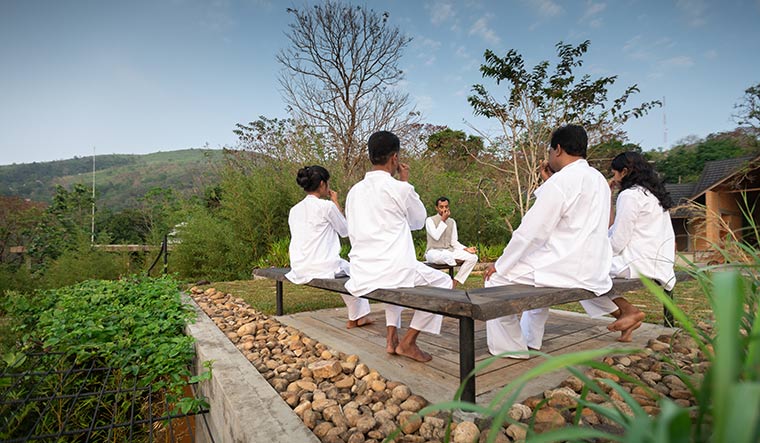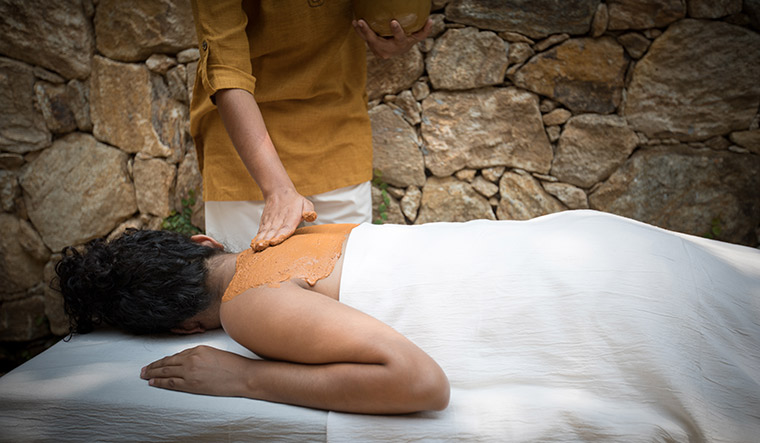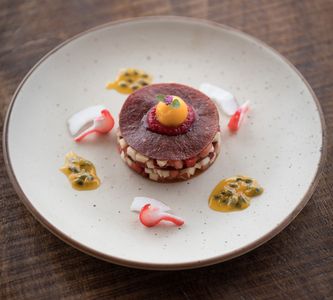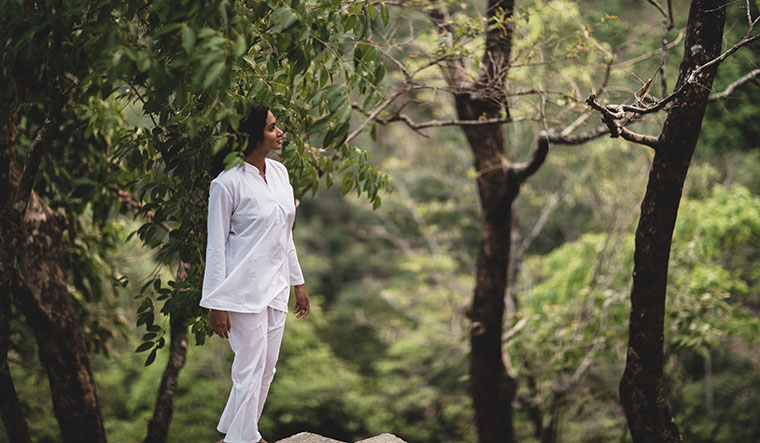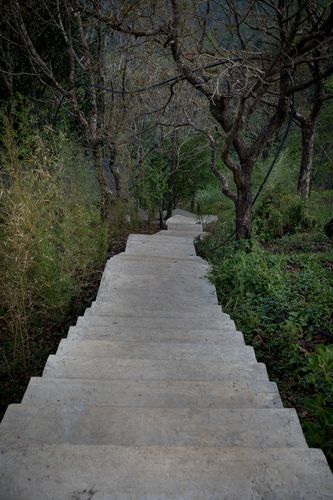A shy sun peeps from behind the rolling Panchalimedu hills, spreading a soft glow around it. Transitioning from gentle hues to bright orange, its brilliance surfaces in phases. This gradual progress to light is mirrored in the dazzling infinity pool at Prakriti Shakti, a premium clinic of natural medicine by CGH Earth. This phasing process also seems to be reflected in the way its treatments are programmed—you are slowly initiated into them. Only here the progress is towards the metaphorical light (knowledge), as also lightness of the body and mind.
Started more than a year ago, Prakriti Shakti, nestled among the Panchalimedu hills in Idukki, Kerala, is quaint, quiet (you can hear the wind whispering through the trees) and calming. Nature starts to work its magic on you almost instantly here—your tensed body and mind start to unwind. But Prakriti Shakti is no spa resort; there is more to it than just relaxation. Here, you are not just a guest but also a patient. There are personalised naturopathy treatments for lifestyle and chronic ailments, like obesity, diabetes, hypertension, high cholesterol, cardiovascular diseases and stress-induced disorders. These could last between 14 and 21 days or more.
But Dr Cijith Sreedhar, chief medical officer, Prakriti Shakti, explains, “We tell everyone who comes here, ‘You are not here to treat any specific disease. That is actually a byproduct. Your purpose of being here is twofold: to listen to your body and to take responsibility of whatever happens in your body, and to understand how your body can heal itself when a chance is given.’”
The clinic is not just for people with specific illnesses though; it has a seven-day detox programme for those who want to give their body a break from the daily grind. The programme begins with the constructive phase for rejuvenating the body, moving to the soothing one for relaxing it, then to the eliminative phase for cleansing the body and back to the soothing and constructive phases. The treatments in each phase vary, and are complemented by a raw diet—fresh, lively, wholesome, rainbow food. Raw food contains natural enzymes and minerals that help in digestion, and it also has fibre, which is food for good bacteria, explains Sreedhar. In the constructive phase, you get solid, chewable food (for maximum nourishment and to boost immunity); the soothing phase has juices and smoothies (to revitalise the digestive system); and the eliminative phase has only thin liquids (easy to digest). I am here for a shorter duration, so I undergo detox treatments from each of the three phases, but my diet is constructive through my stay.
The overwhelming emotion I feel during my stay at Prakriti Shakti is surprise. And it hits me right from the first sip of the welcome drink—sambaram (spiced buttermilk)—the team serves. Since they do not use milk or milk products here, the sambaram is made of coconut milk. After changing into the uniform provided by the clinic, I head to the dining area, with a picturesque view of the infinity pool and the hills, for lunch (usually, there is only brunch at 10am, followed by tender coconut water at 1pm). Say the term raw food, and most of us think of salads. But senior master chef Gireesh Kumar P.C. and his team are out to change that thought with their fireless kitchen. Chef Gireesh says he has created more than 700 recipes for the different phases of the treatment plan. So for lunch I have a three-course meal—carrot and cilantro gazpacho (cold soup) with (dehydrated) kale chips and crackers for starters, broccoli square for main course and avocado lemon tart (base made with cashew, pistachio, dry coconut, lemon zest and dates and filled with avocado, honey, lemon juice and lemon zest) for dessert. From famished I was full, all in one delicious helping. And you are free to ask for a second helping. It is all about listening to your body, remember?
That is a point that stands out during my consultations with Sreedhar and his team of doctors and therapists. Every disease or discomfort is a message from the body, he says, and naturopathy tackles its root cause. After he notes down my medical history, a treatment plan is prepared. I next head to the therapy room for the rejuvenating massage, which helps release knots and tight muscles in the body and improves blood circulation. At 5pm, Sreedhar conducts Dhyana Yoga, where he helps me and three other patients—all from abroad—meditate. The next session piques my interest, as the chef and his team demonstrate how to make the food they serve here once we are back home. For dinner, I am served an ivy gourd stuffed with finely chopped bell pepper and pineapple (starters), pizza made from fruits, dry fruits and vegetables (main course) and anjeer barfi (dessert). The day ends with a video session on gut—our second brain—and its importance. I am a tad tired by the end of it, but it is expected as the body is only getting used to the treatment and the change in diet. The daily ‘nightcap’—gooseberry juice—arrives at 8pm, and it is your cue to call it a night. You are also given a glass of water infused with basil seeds, which you have to drink first thing in the morning.
Days at Prakriti Shakti begin before the sun is up and bright in the sky. You have to be in the dining area by 6.20am for the wakeup juice (ivy gourd juice, snake gourd juice and ridge gourd juice for me during my three-day stay), after which you do barefoot walking and sun-gazing for half an hour. It is a daily activity, just like the 15-minute reflexology walk—a pathway filled with pebbles and water to stimulate the reflex points in your feet—following your consultation with the doctor. The barefoot walking and sun-gazing, a luxury for most city-dwellers, calms me. The reflexology walk, however, is painful. But the points that ache indicate an underlying problem—less intake of water in my case.
After your time in the sun, you stretch. Each session of Soukya Yoga, starting 7am, focuses on a particular system of the body, like breathing or metabolism. Samana Yoga, on the other hand, involves personalised sessions, designed keeping the patient’s overall health in mind and are conducted individually. Post Soukya Yoga, you get a juice at 8am (kale juice, chocolate smoothie and celery juice for me).
And, you are back in the sun, which, like other elements of nature, is an integral part of most treatments here. Sunbathing with eye and abdominal mud pack, also a daily activity, helps reduce strain on eyes and alleviate indigestion. This proves to be a precursor, of sorts, to what is in store for me after brunch (ragi neeru, string hoppers made from cucumber and vegetable stew). The full mud bath therapy blows my mind. With “purified, therapeutic” and cold mud slathered on my body, I am made to soak up the sun for an hour. The therapy, done during the eliminative stage, is said to absorb toxins from the body and better the blood circulation, and therefore is an ideal treatment for skin ailments. I also get a hip cold bath—good for colon, kidney, abdominal and reproductive organs—in the afternoon after the colouring session. I cannot paint to save my life, so by the end of it my face is a deeper shade of red (with embarrassment) than the one in my work of ‘art’.
While the daily schedule is packed with activities, the doctors ensure that you do get time to rest. So, I take an afternoon nap before heading for the Dharana Yoga, which aids in developing deep concentration. And, that nap, perhaps, helps me stay alert during the Yoga Nidra technique taught at the session. This is followed by the interactive cooking session and dinner (garden green gazpacho, baby corn sprouts burger and brownie). For someone who has trouble falling asleep at night, sleep does come easy to me here.
The next morning at 6.30, another patient and I are taken to the Panchalimedu hills for a walk, instead of the barefoot walking and sun-gazing. Sitting at the top, surrounded by lush greenery, it truly feels like we are in Mother Nature’s lap. My schedule is almost similar to the previous day’s, except for the treatments. I go for a mud application to the spine after having a glass of Indian pennywort juice and the consultation with the doctor. Later, in the afternoon, I have a banana leaf sun bath, where I lie in the sun with banana leaves wrapped around my body. The treatment is said to open up skin pores and relax the muscles.
Before the treatment, however, I have the best meal of my stay at Prakriti Shakti. Since I am leaving the next day, I am served the sadhya—traditional Kerala meal served on a banana leaf. From the curries to pickles to rice (made from sprouted coconut and cauliflower), everything on the leaf is uncooked, plant- or fruit-based. Moreover, the chef and his team manage to nail the taste. The dinner is no less delicious—pineapple gazpacho, zucchini pasta with nut balls and marinara, and chocolate mousse.
On my last day, I undergo a relaxation massage to ease the stress nodes in my body. Soothed, I head to calm my growling stomach with sesame milk shake and fruit pancake. I then go for my final consultation with the doctors. It is during this last visit to the doctors that a detailed plan, including mind and body exercise, rest and relaxation and diet, is prepared for patients to follow once they are back home. And, there is no insistence on eating only raw food once they are home, says Sreedhar. Include it as much as you can and focus on cooking and eating the healthy way.
What’s my takeaway from my stay, you ask. Sreedhar’s initial words to me: Listen to your body and be responsible. And, of course, raw food rocks!



